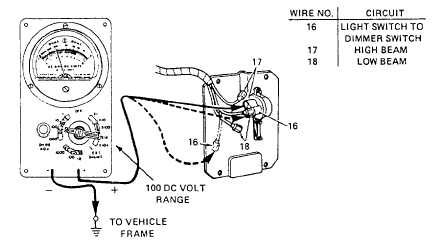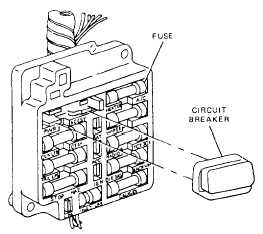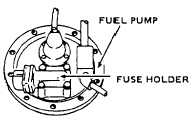
Figure 4-44.-2 1/2-ton military truck foot-operated dimmer switch electrical test.
Obtain a wiring diagram for the particular system you are working with, and trace the circuit back to the next major multi wire connector, then to the light switch itself. Remember, try to avoid unnecessary cutting into wiring looms or harnesses as this type of damage causes moisture to be allowed into the wiring system.
If the headlights do not switch from low beam to high beam, find the dimmer switch (foot operated or steering column mounted), then refer to the wiring diagram (fig. 4-44) and test for voltage.
In the case of all of the headlights being out at the same time, check the fuse; then check for power flow to the light switch. If necessary, remove the light switch from the vehicle and test it on the bench. The problem of dim headlights could mean the following things:
Low battery voltage
Poor connections in the circuit
Faulty ground wires
Incorrect voltage head lamps
FUSES AND CIRCUIT BREAKERS
Fuses or circuit breakers are put into electrical circuits to prevent damage from electrical overload. Normally, fuses are mounted in a cluster or fuse block (fig. 4-45). Some may be remotely mounted away from the fuse block, in which case, you will have to get under the dashboard or hood and hunt for them. Still others may be mounted within the circuitry of the accessory (fig. 4-46) that you are testing. Fusible links are usually marked and mounted close to the battery.
Testing fuses is quite simple. You should use a 12/24 test lamp. Attach one end to a good ground, energize the circuit, and use the probe to test both ends of the fuse. If a burned fuse is found, keep in mind there is a reason for it. Trace the circuit and find the fault before replacing the fuse.

Figure 4-45.-Fuse block with fuses and circuit breaker.

Figure 4-46.-Example of an accessory mounted fuse.
Continue Reading